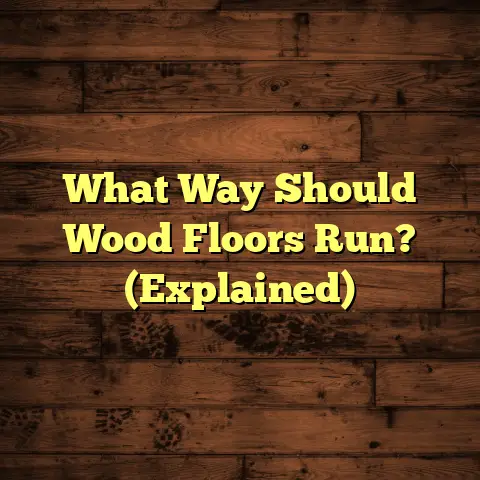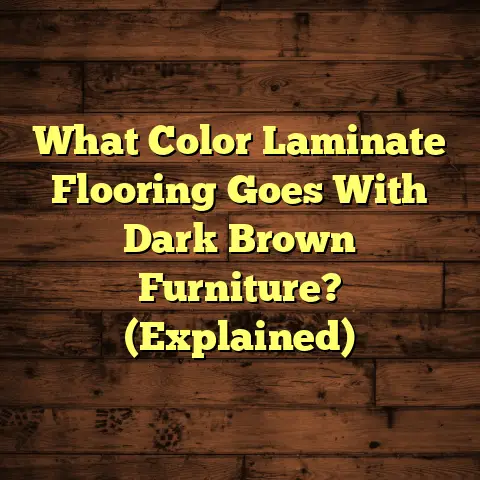Rug Pad on Hardwood? Quick Answer! (3 Pads Avoid!)
I’m a flooring contractor, and I’ve seen it all when it comes to hardwood floors.
From stunning installations to heartbreaking damage, I know firsthand how to keep these beauties looking their best.
Hardwood floors are super popular these days.
They bring a touch of elegance and warmth to any home, right?
Plus, they’re durable and can last for decades with the proper care.
But let’s be real, life happens, and our floors need all the help they can get!
That’s where rug pads come in.
They’re not just about keeping your rug in place; they’re essential for protecting your hardwood, adding comfort, and boosting safety.
But here’s the catch: not all rug pads are created equal.
Some can actually do more harm than good.
So, let’s dive into the world of rug pads and I’ll share my expert insights on what to use and, more importantly, what to avoid!
1. The Ease of Cleaning Hardwood Floors with Rug Pads
Okay, let’s talk cleaning.
I know, it’s not everyone’s favorite topic, but keeping your hardwood floors clean is crucial.
And guess what?
The right rug pad can make this chore a whole lot easier!
Think about it: without a rug pad, dirt, dust, and crumbs can easily get trapped under your rug, scratching the surface of your beautiful hardwood.
A good rug pad acts as a barrier, preventing that gunk from accumulating and making cleanup a breeze.
I’ve seen homes where the difference is night and day.
With the right pad, you can simply lift the rug, vacuum the floor, and you’re done!
No more struggling to get rid of embedded dirt.
Now, the material of your rug pad also plays a role.
Non-slip pads, for example, keep the rug firmly in place, so you won’t have to readjust it every time you vacuum.
Moisture-resistant pads are also a great choice, especially in kitchens or entryways where spills are more likely.
These pads prevent liquids from seeping through and damaging your hardwood.
Here’s a quick cleaning tip I always share: Vacuum your hardwood floors at least once a week, and spot clean any spills immediately.
With a good rug pad in place, this routine will keep your floors looking spotless and extend their lifespan.
I usually advise homeowners to lift and clean under their rugs every 1-3 months, depending on traffic.
This prevents any hidden dirt buildup from becoming a problem.
2. The Importance of Choosing the Right Rug Pad
So, why is picking the right rug pad so important?
Well, it’s about more than just keeping your rug from sliding around.
A good rug pad performs several crucial functions:
- Cushioning: Adds extra comfort underfoot, making your rooms feel cozier.
- Grip: Prevents slips and falls, especially important if you have kids or pets.
- Protection: Shields your hardwood from scratches, dents, and stains.
I’ve seen firsthand how a quality rug pad can extend the life of both your rug and your hardwood floor.
It’s an investment that pays off in the long run.
Think of it this way: your hardwood floor is like a fine piece of furniture, and a rug pad is like a protective cover.
You wouldn’t leave your furniture exposed to the elements, would you?
The same goes for your floors!
“Non-slip” is the keyword here.
A rug pad with good grip is essential for safety, especially in high-traffic areas like hallways and living rooms.
I can’t tell you how many times I’ve seen accidents caused by rugs sliding out from under people.
A non-slip rug pad can prevent these accidents and give you peace of mind.
When choosing a rug pad, also consider its thickness and material.
Thicker pads provide more cushioning, while thinner pads are better for low-profile rugs.
The material should be compatible with your hardwood floor.
Some materials can react with the finish and cause damage.
I’ll get into the specific types to avoid in the next section.
3. Three Rug Pads to Avoid on Hardwood Floors
Alright, let’s get down to the nitty-gritty.
I’m going to share my list of rug pads that you should absolutely avoid using on your hardwood floors.
These pads might seem like a good idea at first, but trust me, they can cause serious problems down the road.
3.1. Foam Pads
Foam pads are often marketed as an affordable and comfortable option, but they’re a big no-no for hardwood.
Here’s why:
- Moisture Trap: Foam is porous and tends to trap moisture.
Over time, this moisture can seep into your hardwood, causing warping, staining, and even mold growth. - Compression: Foam pads compress easily, losing their cushioning and grip.
This leads to slipping and rug movement, defeating the purpose of the pad.
I’ve seen cases where homeowners used foam pads in their bathrooms, and the resulting water damage was extensive.
The cost of repairing the hardwood far outweighed the initial savings on the rug pad.
According to the National Wood Flooring Association (NWFA), excessive moisture is one of the leading causes of hardwood floor damage.
Foam pads exacerbate this problem, creating a breeding ground for moisture-related issues.
3.2. Rubber Pads
Rubber pads might seem like a good choice for grip, but they can also be problematic for hardwood floors.
Here’s what you need to know:
- Discoloration: Some rubber pads can cause discoloration of the hardwood finish.
The chemicals in the rubber can react with the finish, leaving unsightly stains. - Sticky Surface: Rubber can create a sticky surface that attracts dirt and debris.
This makes cleaning more difficult and can damage the hardwood over time.
I’ve encountered situations where rubber pads left permanent marks on hardwood floors, requiring costly refinishing.
The type of rubber matters too.
Avoid pads made with PVC or other synthetic materials, as they are more likely to cause damage.
Natural rubber is a better option, but even then, it’s essential to test it in an inconspicuous area first.
3.3. Felt Pads
Felt pads are often used to protect hardwood floors from scratches, but they have some significant drawbacks:
- Lack of Grip: Felt pads tend to slide easily on hardwood surfaces.
This can be dangerous, especially on stairs or in areas with heavy foot traffic. - Scratches: While felt can protect against minor scratches, it can also trap dirt and debris, which can then scratch the floor as the pad moves around.
I’ve seen felt pads contribute to scratches on hardwood floors, especially when they’re not anchored properly.
The constant movement of the pad grinds dirt and debris into the finish.
Felt pads are better suited for use under furniture legs, where they can prevent scratches without the risk of sliding.
However, for rugs, they’re not the best choice.
4. Alternative Rug Pad Options for Hardwood Floors
Okay, so we’ve covered the rug pads to avoid.
Now, let’s talk about some better alternatives that will protect your hardwood floors and keep your rugs in place.
Here are a few of my go-to recommendations:
- Natural Rubber Pads: Made from natural rubber, these pads provide excellent grip without the risk of discoloration or damage.
- Memory Foam Pads: These pads offer superior cushioning and comfort.
Look for memory foam pads with a felt or rubber backing for added protection. - Felt Pads with Rubber Backing: These pads combine the scratch protection of felt with the grip of rubber.
The rubber backing prevents the pad from sliding and keeps your rug securely in place.
I personally prefer natural rubber pads for their durability and eco-friendliness.
They’re a bit more expensive than other options, but they’re worth the investment in the long run.
When choosing a rug pad, always read the label and check for certifications.
Look for pads that are labeled as “safe for hardwood floors” or “non-staining.”
It’s also a good idea to test the pad in an inconspicuous area before placing it under your entire rug.
This will help you identify any potential issues before they cause damage.
Conclusion
Choosing the right rug pad is essential for protecting your hardwood floors and keeping your rugs in place.
By avoiding foam, rubber, and felt pads, and opting for better alternatives like natural rubber, memory foam, or felt with a rubber backing, you can ensure that your floors stay beautiful and your rugs stay put.
Remember, a little bit of research and a smart choice can save you a lot of headaches and expenses down the road.
So, take your time, do your homework, and choose a rug pad that’s right for your floors and your lifestyle.
Your hardwood floors will thank you for it!





